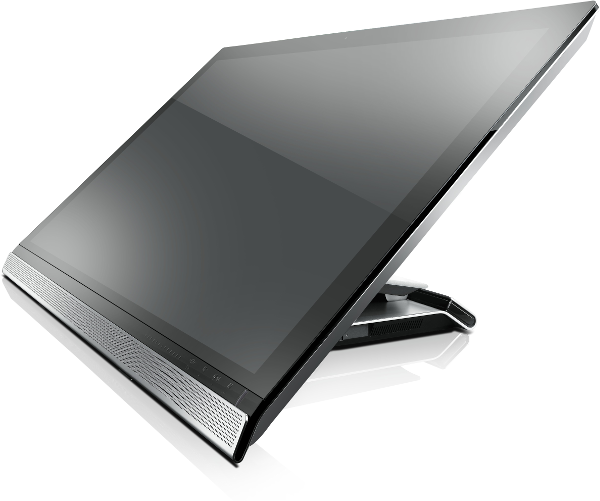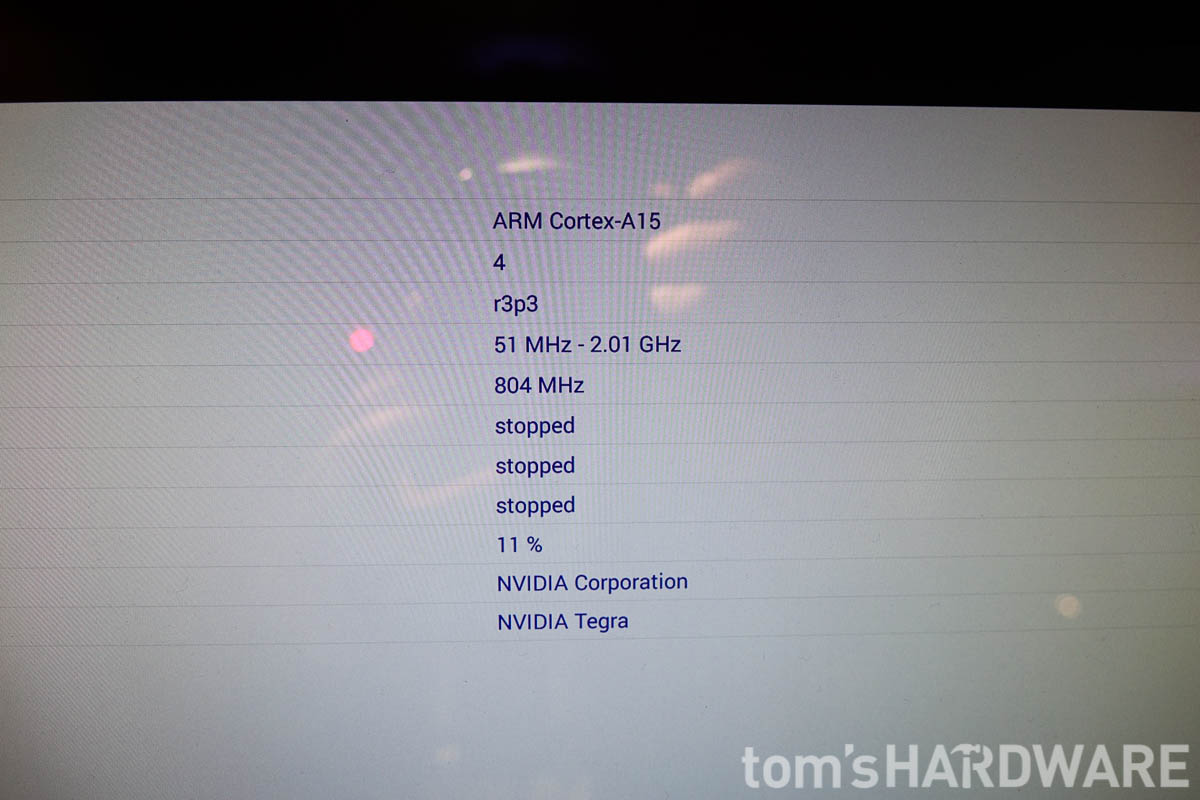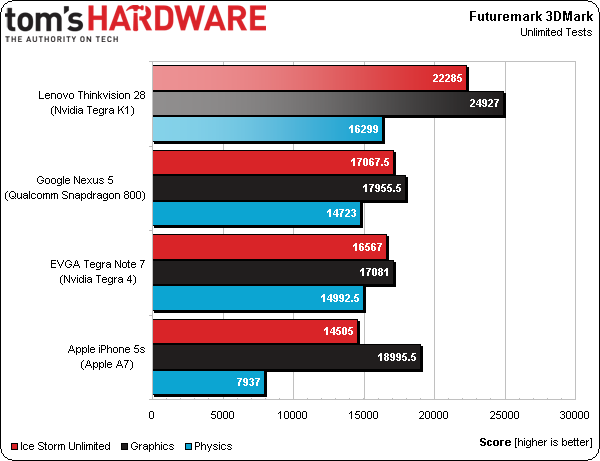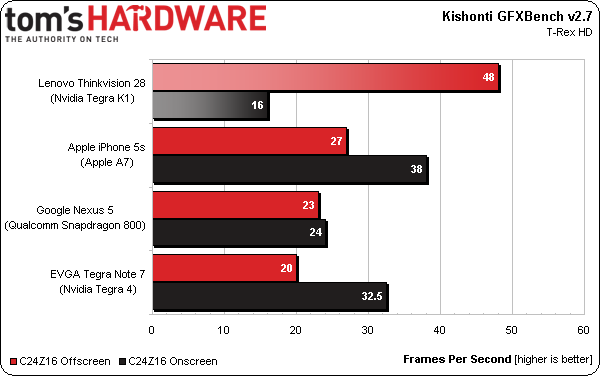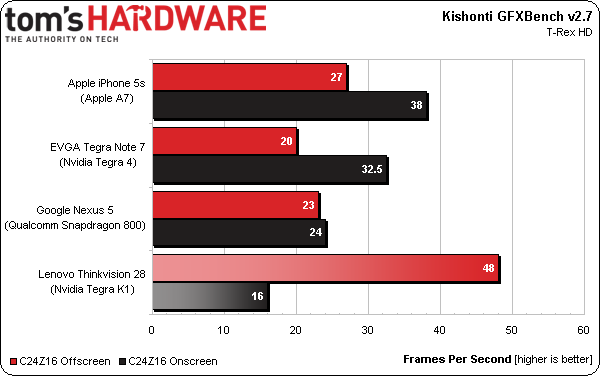Nvidia Tegra K1 Benchmarks from Lenovo ThinkVision 28
Nvidia is claiming the new mobile performance king at CES this year with its new Tegra K1 SoC. Luckily, Lenovo had a working K1-based product on the showroom floor, and we managed to run a few benchmarks. So, does Nvidia’s new Tegra live up to the hype?
One of the more unique products at CES 2014 was Lenovo’s ThinkVision 28. Positioned as a 4K (3840x2160) 28” LCD “pro monitor”, which happens to also run Android, the ThinkVision 28 will be available in July, starting at $1000. The ThinkVision 28 is part of the PC Plus movement, and while marketed primarily as a display (hence the ThinkVision moniker), this is a full system here, folks.
This “monitor” features Android 4.3, Nvidia’s Tegra K1 SoC, 2 GB DDR3, 32 GB eMMC storage, a microSD slot, three USB 3.0 ports, one USB 2.0 port, one microUSB 3.0 port, audio in/out, speakers, mics, webcam, Ethernet, Wi-Fi, Bluetooth 4.0, NFC, Miracast, three HDMI ports, one DisplayPort, and a 10-point touchscreen.
The key aspect is, of course, the display. It’s 2160p Ultra HD. 4K is cool right now. Everyone wants 4K. But what we’re really interested in today is what powers the ThinkVision 28: Nvidia’s new Tegra K1 SoC.
While Lenovo didn't explicitly confirm or deny the SoC’s inclusion in its ThinkVision 28 display, knowing winks and smiles were the order of the day when the question came up. CPU-Z just reports the SoC as “Tegra 2”, which is possibly a holdover from Lenovo’s old Tegra 2-based “K1” tablet - a little irony in itself.
The ThinkVision 28’s Tegra K1 contains four ARM Cortex-A15 CPU cores reported to run at 2 GHz, plus one low speed companion core likely operating at 500 MHz (as with Tegra 3 and 4), and a Kepler-based graphics engine with one SMX unit consisting of 192 CUDA cores. We weren't able to pull the GPU's clock rate, but we suspect it's lower than the ~950 MHz guessed by Angelini in his preview of the AP.
Interestingly, Nvidia says the K1 can run at up to 2.3 GHz, so it's possible that either CPU-Z isn't recognizing the SoC's frequency yet or Lenovo is running the application processor around 15% below its ceiling. Let’s see how it fares in some benchmarks.
Since people are going to be most interested in the 192-core Kepler GPU, our tests will focus primarily on graphics.
Get Tom's Hardware's best news and in-depth reviews, straight to your inbox.
3DMark
3DMark is a multi-platform graphics benchmark that contains both graphics and physics tests. The Unlimited version runs at an off-screen resolution of 720p, allowing for chip-to-chip comparisons, rather than forcing us to take each device's panel into consideration, too.
Based on our initial look at Tegra K1 in Lenovo's ThinkVision, the SoC far outperforms any of its competition, posting 25%-higher results in the GPU-heavy graphics workload and CPU-limited physics test.
If the Tegra K1 is indeed operating at a lower-than-peak clock rate, that might explain the slight performance bump from EVGA's Tegra 4-based Tegra Note 7, which also features four Cortex-A15 cores based on a previous revision. Still, at almost 15% faster than the Qualcomm's Snapdragon 800 (at 2.26 GHz), the Tegra K1 still fares really well against Krait. With Snapdragon 805 now on the horizon, it'll be interesting to see how these results are affected by even higher frequencies.
GFXBench
This multi-platform test renders a scene where a lot of effects interplay along with some physics and additive lighting. Off-screen is tested at 1920x1080, while on-screen relies on the display's native resolution. Although GFXBench 3.0 is now available, 2.7 was the version installed on the ThinkVision 28 floor model.
In the off-screen test, Tegra K1 comfortably takes the lead over Apple's A7 (by almost double)! Qualcomm’s Snapdragon 800 and Nvidia’s Tegra 4 are in third and fourth place respectively, scoring within 10% of one another.
The on-screen test tells a different story, since display resolution has as much impact as raw GPU power. Nvidia's Tegra K1 suffers under the demands of Lenovo’s UHD panel, slipping from first place in the off-screen test to last place in this benchmark. Both sub-FHD devices, the Apple iPhone 5s and EVGA Tegra Note 7, easily take first and second place. Google’s Nexus 5 is also punished for its 1080p display, but still manages to render an almost-playable 24 frames per second.
AnTuTu
AnTuTu is more of a general system benchmark, where almost every aspect is either derived from or directly affected by CPU core performance. As such, we felt it necessary to include the result, even if only to indicate the expected performance of the Tegra K1 when clocked below peak performance.
Interestingly, the Tegra K1 wins the UX test by a significant margin of roughly 5%, even though it’s driving a 4K display in the Lenovo ThinkVision 28. However, it is possible that Android 4.3’s full HWCOMPOSE support is offering better UI performance than the Tegra Note’s Android 4.2. In any case, the EVGA’s Tegra 4 beats both the Nexus 5’s Snapdragon 800 and the potentially underclocked Nvidia Tegra K1.
Potentially The Next Big Thing In SoCs
While we’re still in the very early days of Nvidia’s Tegra K1 (and 4K displays for that matter), the immediate results do indeed seem promising. If real-world performance in any way matches what we see in these few benchmarks, the K1’s 192-core Kepler-based GPU could prove to be a game-changer for mobile graphics, driving high detail levels in content previously only seen on the PC and consoles.
And that’s without benchmarking Denver, where ARMv8 could offer even more performance. Next level, indeed.
Read our technical look at the Tegra K1 here.
Follow Dorian and Tom's Hardware on Google+
-
esrever Comparing a tablet to a phone isn't really a fare comparison. Sure the performance is there but what about power consumption and temperatures?Reply -
therealduckofdeath @esrever Tablets and phones tend to use identical or very similar processors today. They're good enough to get a reference.And as I suspected, the Nvidia hyperbole about it being as powerful as a desktop PC or high-end console was nothing but hyperbole.... :)Reply -
esrever Reply12428904 said:@esrever Tablets and phones tend to use identical or very similar processors today. They're good enough to get a reference.And as I suspected, the Nvidia hyperbole about it being as powerful as a desktop PC or high-end console was nothing but hyperbole.... :)
Even when listed as the same part many tablet SoCs will run faster then phone SoCs due to thermal throttling on phones. Tegra 4's power consumption is why its only in a few tablets and not in an phones. -
fteoOpty64 This is a nice "surprise" which I think was well done and discretely persuaded by Lenovo. It is one way to unofficially demonstrate that K1 is already in "risk production" thus has the potential to throw competitors in a jam. Here is looking at you QC!.A display like the Thinkvision28 is inovative in that it can be used for Android games while connected to be a main or secondary display for a PV or laptop. For larger tablets of 12 inches, the cpu power can certainly be useful. So let the super-tablets start competing ....Reply -
kratosbellic what next compare r9 290x with a phone, and see how revolutionised pc platform isnext show phones that have Tegra k1 and then compare it with Nexus 5 or GS4Reply -
kratosbellic Replywhat next compare r9 290x with a phone, and see how revolutionised pc platform is, next time show phones that have Tegra k1 and then compare it with Nexus 5 or GS4
-
therealduckofdeath @esrever The Nexus 7 Tegra 3 was clocked lower than a lot of contemporary phones with that chip. It's not quite that easy. The Galaxy Note 3 and Note 10.1 2014 edition use identical processors. It's not quite like laptops and PC's on the phone/tablet market. They usually tend to use identical processors. Differences in performance are often down to type of RAM and storage. The Tegra 4 was a bad, bad design, that's why it was almost not used by anyone.Reply -
Jeff Gilleese Isn't the Snapdragon 805 supposed to have a %40 graphics performance gain over the 800? If so wouldn't that put the 805 in a dead heat with the K1 running full 2.5GHz clock speed?Reply -
Jeff Gilleese Isn't the Snapdragon 805 supposed to have a %40 graphics performance gain over the 800? If so wouldn't that put the 805 in a dead heat with the K1 running full 2.5GHz clock speed?Reply
